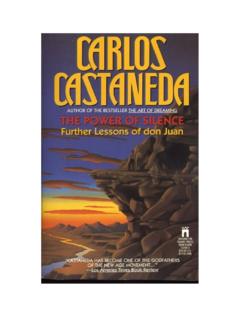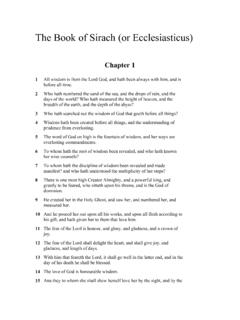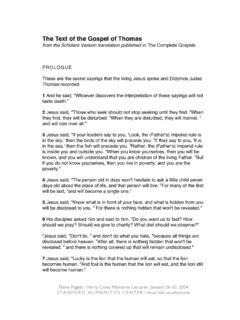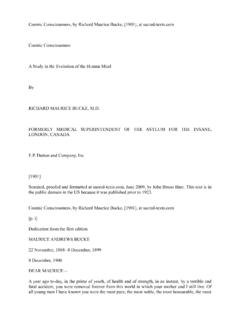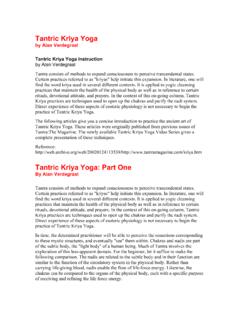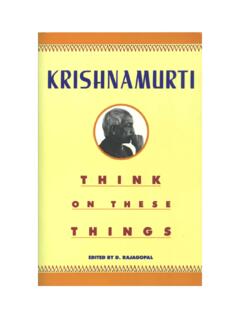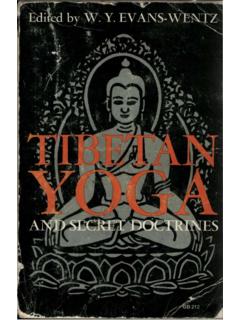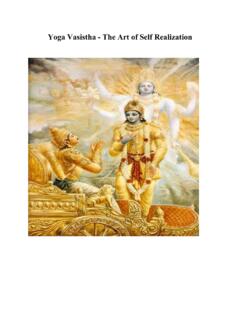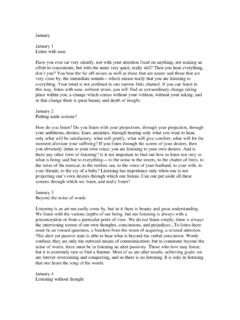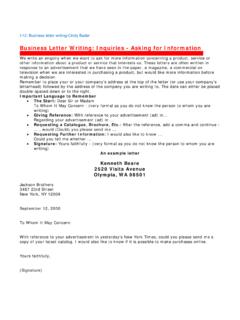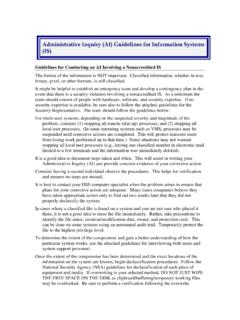Transcription of SELF - ENQUIRY
1 self - ENQUIRY (VICHARASANGRAHAM)OFBHAGAVAN SRI RAMANA MAHARSHIA new translation byDR T. M. P. MAHADEVAN, , the original TamilPUBLISHED BYV. S. RAMANANP resident, Board of TrusteesSRI RAMANASRAMAMTIRUVANNAMALAISOUTH RamanasramamEighth edition 1971 Ninth edition 1981 Tenth edition 1990 Reprint 1994 INTRODUCTIONThe present work in prose consists of forty questions with answers covering the entire range ofspiritual disciplines required for the gaining of release (moksha). The questioner was GambhiramSeshayya, one of the early devotees of Bhagavan Sri Ramana Maharshi. He was a MunicipalOverseer at Tiruvannamalai about 1900.
2 Besides being an ardent Ramabhakta (worshipper ofRama) he was interested in the study and practice of Yoga. He used to read Swami Vivekananda slectures on the different yoga s as also an English translation of the Rama-gita. For resolving thedifficulties which he came across while studying these books and in his spiritual practices, heapproached Bhagavan Sri Ramana from time to time. Bhagavan, who was only twenty-one yearsold, was then living in Virupaksha cave on Arunachala Hill. As he was keeping silent at the timenot because of any vow taken but because he was not inclined to talk - he wrote out his answers toSeshayya s questions on bits of paper.
3 These writings over the period 1900-1902 were latercopied in a note-book by Seshayya. The material thus gathered was published by Sri Ramanasramamunder the little Vichara-sangraham which literally means A Compendium of self - ENQUIRY . Adigest of the teaching contained in this work was later printed in English bearing the title self - ENQUIRY . In that English version, the questions were omitted and the substance of Bhagavan steaching was given, classifying it in twelve short chapters with appropriate headings. The presentEnglish translation is of the entire original text Vichara-sangraham as it is in Tamil.
4 The Vichara-sangraham has unique value in the sense that it constitutes the first set of instructions given byBhagavan in his own careful study of the instructions given by Bhagavan here will reveal that they are based on his ownplenary experience as confirmed by the sacred texts which were brought to his notice by the earlydevotees and which he perused for the purpose of clearing the doubts that arose in the minds of thedevotees. In the course of his instructions, Bhagavan makes use of such expressions as, the scripturesdeclare , thus say the sages, etc.; he also cites passages from texts like the Bhagavad Gita and theVivekachudamani and once he mentions by name the Ribhu Gita.
5 But it is quite clear that these citationsare offered only as confirmations of the truth discovered by Bhagavan himself in his own basic teaching is that of Advaita-Vedanta. The plenary experience of the non-dual self is thegoal; ENQUIRY into the nature of the self is the means. When the mind identifies the self with the not- self (the body, etc.), there is bondage; when this wrong identification is removed through theenquiry Who am I ? there is release. Thus, self - ENQUIRY is the direct path taught by BhagavanRamana. The I-experience is common to all. Of all thoughts, the I-thought is the first to one has to do is to enquire into the source of the I-thought.
6 This is the reverse process ofwhat ordinarily happens in the life of the mind. The mind enquires into the constitution and sourceof everything else which, on examination, will be found to be its own projection; it does notreflect on itself and trace itself to its source. self -discovery can be achieved by giving the mind aninward turn. This is not to be confused with the introspection of which the psychologists is not the mind s inspection of its own contents; it is tracing the mind s first mode, the I-thought to its source which is the self . When there is proper and persistent ENQUIRY , the I-thought also ceases and there is the wordless illumination of the form I-I which is the pureconsciousness.
7 This is release, freedom from bondage. The method by which this is accomplished,as has been shown, is ENQUIRY which, in Vedanta, is termed jnana, knowledge. True devotion(bhakti), meditation (dhyana), and concentration (yoga) are identical therewith. As Bhagavanmakes it perfectly clear, not to forget the plenary self -experience is real devotion, mind-control,knowledge, and all other austerities. In the language of devotion, the final goal may be describedas the resolution of the mind in its source which is God, the self , in that of technical yoga, it maybe described as the dissolution of the mind in the Heart-lotus.
8 These are only different ways ofexpressing the same path of self - ENQUIRY is found difficult by those who have not acquired the necessary competencefor it. The mind should first be rendered pure and one-pointed. This is done through meditation,etc. So, the various paths, in their secondary sense, are auxiliaries to the direct path which is self - ENQUIRY . In this context, Bhagavan refers to three grades of aspirants: the highest, the medium, andthe lowest. For the highest type of aspirants, the path prescribed is Vedanta ENQUIRY ; through thispath, the mind becomes quiescent in the self and finally ceases to be, leaving the pure self -experience untarnished and resplendent.
9 The path for the medium is meditation on the self ;meditation consists in directing a continuous flow of the mind towards the same object; there areseveral modes of meditation; the best mode is that which is of the form I am the self ; this modeeventually culminates in self -realization. For the lowest grade of aspirants, the discipline that isuseful is breath-control which in turn results in mind explains the difference between jnana-yoga (path of knowledge) and dhyana-yoga(path of meditation) thus: jnana is like subduing a self -willed bull by coaxing it with the help of asheaf of green grass, while dhyana is like controlling it by using force.
10 Just as there are eightlimbs for dhyana-yoga, there are eight for jnana-yoga. The limbs of the latter are more proximateto the final stage than those of the former. For instance, while the pranayama of technical yogaconsists in regulating and restraining breath, the pranayama that is a limb of jnana relates torejecting the name-and-form world which is non-real and realizing the Real which is of the self can be gained in this very life. In fact, self -realization is not somethingwhich is to be gained afresh. We are already the self ; the self alone is. It is ignorance that makesus imagine that we have not realized the self .
